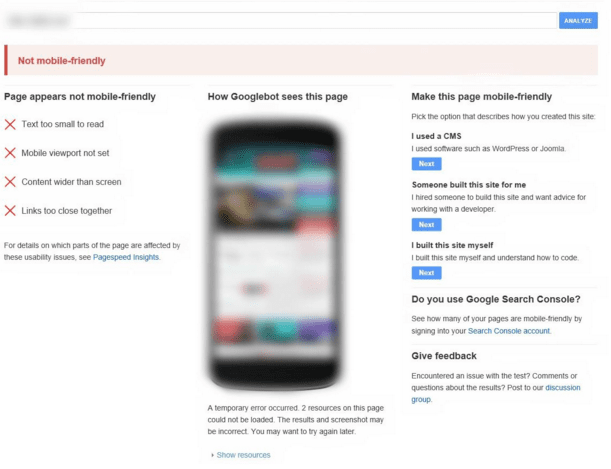Share this
4 Most Common Mistakes on Manufacturing Websites
by SyncShow on Tue, Mar 29, 2016 @ 09:18
Business websites are the most important components and the focal points of every company’s online marketing strategy. Given its importance, it is surprising to hear that one third of visitors to manufacturing websites rate them as “very bad” (joint study by Google and ThomasNet). But that’s not all: two thirds of visitors also say that they never return after having a bad user experience. What exactly is causing these negative impressions of manufacturing sites? We’ve identified four common problems and offered practical guidelines that can help you fix them.
1. There’s too much information and the copy is difficult to read
Many times, manufacturing websites can feel more like an online brochure rather than a website. Too much information is crammed into walls of text, which makes it difficult for the visitor to navigate the page and find the exact information they need.
Is all of this content necessary? A study conducted by Nielsen Norman Group revealed that almost 80% of web users will not read all of the content that is on a page. In fact, the briefer, clearer and more scannable the copy is, the larger portion of it that is going to be read.
The Solution
In order to ensure fast and easy access to pertinent information, you might need to reconsider how content is organized throughout your company’s website. Establish a clear goal for each of the pages and include only the content that will facilitate accomplishing that goal. Organize it into smaller pieces and use bullet points to make it easier on the eyes. If you need to include detailed documents such as Material Safety Data Sheets, consider offering them in downloadable formats.
2. There is no Call-to-Action (CTA)
Failure to add CTAs is another problem that keeps manufacturing websites from reaching their potential. Once you’ve captured your website visitor’s attention with content, you need to lead them to making a decision and taking action. Otherwise, once they leave your website, you’ll lose a potential lead.
Practically speaking, CTAs are buttons that take visitors to a page where they can take a desired action. Whether it is completing an online form to request a price quote, downloading a case study or calling a local sales representative, it all depends on how ready your website visitors are to make that purchase. Not all leads are going to translate into sales right away, which is why you need to include calls-to-action that will satisfy different needs for your various personas in each phase of their buyer's journey.
The Solution
The best way to approach calls-to-action is to decide on the primary goal for every web page on your site and then create a call to action based on that goal. Ask yourself what it is you want users to do: complete an online form, request a quote, contact a sales representative, or connect with a local dealer. Whatever it is, make sure to express it in simple language that clearly communicates your message.
The goal with CTAs is to funnel your prospects through the buyer's journey. First, you grab their attention with a piece of educational content they'd be interested in. This way, they are willing to fill out the form with their contact information to receive that piece of content. From there, you can target them with email drip campaigns, follow-up emails, and other content offers to push them from a prospect to a customer.
Take a look at this example from Fisher Tank homepage. They’ve included CTAs for getting in touch and requesting a quote for more purchase-ready visitors. At the same time, visitors who are still seeking educational information about different solutions available to them can follow CTAs that will lead them to free educational resources:

3. There is no fresh content
Fresh content is extremely important for user experience so make sure you always have the latest product images and descriptions on your website. If you neglect updating this information, prospective customers can base their purchase decisions on wrong or outdated information, only to find out later that they cannot buy the goods they want.
But there’s more to it than just user experience. Stagnant content negatively affects your position in search engine results – the first place customers go to when they need to find a business that can satisfy their needs. A lack of fresh content is interpreted by search engines as a sign of poor website maintenance, or even inactivity. Consequently, these websites will not show up on the first search result pages that are reserved for businesses with the most competitive websites.
The Solution
To address this problem, consider starting a company blog and regularly updating your homepage with important company information and industry news. There are numerous things you can blog about: common problems customers in the manufacturing industry experience, your company’s culture and history, people behind your brand, manufacturing processes, etc.
4. Website is not optimized for mobile browsing
If you’ve focused on designing your website only from the perspective of a desktop user, you need to know that nowadays, smartphone and tablet users account for the majority of all Internet traffic. Neglecting to create a website that displays well on smartphones and tablets means that you may be keeping a large number of prospects away.
Two frustrating problems that mobile users experience with websites that are designed exclusively for desktop is not being able to read the text without first zooming in, and mistakenly pressing wrong links because navigation is too small and not optimized for tapping. When faced with these problems, 40% of Internet users will leave to a competing website that offers a better mobile experience. Also, more than half will refuse to recommend a business with a poorly designed mobile site.
Moreover, in accordance with the latest trends in Internet search, Google now considers mobile-friendliness of a website as one of the factors that seriously affect page ranking. It evaluates accessibility and readability of websites when they’re viewed on smartphone and tablet devices, and demotes those that deliver poor user experience.
If you’re not sure whether your website is optimized for mobile, head over to Google’s Mobile-Friendly Test and enter your website’s URL:

In case your website is not mobile-friendly, you will see something like this:

THE SOLUTION
Follow the instructions on the right to get information on how to resolve this problem with your website developer. The process usually involves adopting responsive design which allows a website to adjust based on the device it’s being viewed from.
Hopefully, this article has helped you to understand common website problems and their solutions. Remember, investing in your website establishes an online presence that leads to sales growth and increased market share.
|
|
Taylor Moore is a freelance copywriter with a passion for all things business and marketing. For more talk on content marketing, conversion optimization, branding and customer service, follow her @taylormtweets. |
Share this
- Inbound Marketing (125)
- Manufacturing (82)
- Lead Generation (71)
- Website Design & Development (47)
- Social Media (46)
- Online Brand Strategy (38)
- B2B Marketing (37)
- eCommerce (32)
- Digital Marketing (30)
- Expert Knowledge (30)
- Company Culture (22)
- Content Marketing (17)
- Metrics & ROI (16)
- Customer Experience (15)
- Search Engine Optimization (15)
- Marketing and Sales Alignment (13)
- Transportation and Logistics (11)
- Content Marketing Strategy (9)
- Email Marketing (9)
- SyncShow (9)
- Digital Content Marketing (8)
- Digital Sales (8)
- General (8)
- Lead Nurturing (8)
- Mobile (7)
- Brand Awareness (6)
- Industrial Marketing (5)
- Digital Marketing Data (4)
- Transportation Insights (4)
- Video Marketing (4)
- HubSpot (3)
- LinkedIn (3)
- Marketing Strategy (3)
- Professional Services (3)
- Account-Based Marketing (2)
- Demand Generation (2)
- High Performing Teams (2)
- Marketing Automation (2)
- News (2)
- PPC (2)
- SEO (2)
- SSI Delivers (2)
- Synchronized Inbound (2)
- Value Proposition (2)
- Artificial Intelligence (1)
- Budgeting (1)
- Facebook (1)
- In-House Vs. Outsourced Marketing (1)
- Instagram (1)
- KPI (1)
- Logistics (1)
- Marketing Trends (1)
- Networking (1)
- Paid Media (1)
- Portfolio Strategy (1)
- Private Equity (1)
- Retargeting (1)
- Revenue Growth (1)
- StoryBrand (1)
- Storytelling (1)
- Tech Stack (1)
- December 2025 (1)
- November 2025 (3)
- October 2025 (2)
- August 2025 (2)
- July 2025 (1)
- May 2025 (2)
- March 2025 (1)
- January 2025 (4)
- December 2024 (2)
- November 2024 (4)
- October 2024 (4)
- September 2024 (4)
- August 2024 (4)
- July 2024 (1)
- June 2024 (1)
- May 2024 (4)
- April 2024 (1)
- March 2024 (3)
- January 2024 (2)
- December 2023 (4)
- November 2023 (3)
- October 2023 (1)
- September 2023 (4)
- August 2023 (3)
- July 2023 (2)
- June 2023 (2)
- August 2022 (2)
- July 2022 (2)
- June 2022 (1)
- March 2022 (2)
- February 2022 (1)
- January 2022 (2)
- October 2021 (1)
- June 2021 (1)
- May 2021 (1)
- March 2021 (1)
- December 2020 (1)
- October 2020 (2)
- September 2020 (1)
- August 2020 (3)
- July 2020 (3)
- June 2020 (4)
- May 2020 (2)
- April 2020 (3)
- March 2020 (9)
- February 2020 (5)
- January 2020 (6)
- December 2019 (5)
- November 2019 (7)
- October 2019 (6)
- September 2019 (8)
- August 2019 (5)
- July 2019 (5)
- June 2019 (3)
- May 2019 (2)
- April 2019 (1)
- March 2019 (2)
- February 2019 (1)
- January 2019 (2)
- November 2018 (1)
- October 2018 (1)
- September 2018 (1)
- August 2018 (1)
- May 2018 (2)
- March 2018 (1)
- November 2017 (1)
- October 2017 (1)
- September 2017 (1)
- August 2017 (2)
- July 2017 (2)
- May 2017 (1)
- April 2017 (1)
- February 2017 (1)
- January 2017 (1)
- December 2016 (1)
- November 2016 (8)
- October 2016 (7)
- September 2016 (2)
- August 2016 (2)
- July 2016 (6)
- June 2016 (3)
- May 2016 (4)
- April 2016 (6)
- March 2016 (6)
- February 2016 (7)
- January 2016 (7)
- December 2015 (6)
- November 2015 (2)
- October 2015 (3)
- September 2015 (2)
- August 2015 (4)
- July 2015 (9)
- June 2015 (9)
- May 2015 (8)
- April 2015 (8)
- March 2015 (9)
- February 2015 (7)
- January 2015 (8)
- December 2014 (7)
- November 2014 (7)
- October 2014 (5)
- September 2014 (4)
- August 2014 (4)
- July 2014 (4)
- June 2014 (4)
- May 2014 (5)
- April 2014 (4)
- March 2014 (7)
- February 2014 (9)
- January 2014 (7)
- August 2013 (2)
- July 2013 (4)
- June 2013 (6)
- May 2013 (7)
- April 2013 (7)
- March 2013 (5)
- February 2013 (5)
- January 2013 (7)
- December 2012 (4)
- November 2012 (3)
- October 2012 (2)
- September 2012 (1)
- July 2012 (1)
- April 2012 (3)
- March 2012 (5)
- February 2012 (2)
- January 2012 (1)
- November 2011 (1)
- May 2011 (3)
- April 2011 (1)
- December 2010 (2)
- November 2010 (2)
- August 2010 (1)
- May 2010 (2)
- April 2010 (1)
- January 2010 (1)




